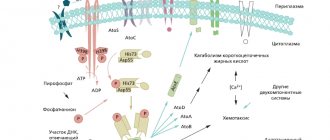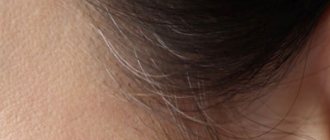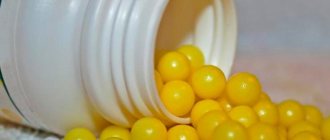Nicotinic acid is a vital vitamin, the supply of which is absolutely necessary for all people, including healthy ones. The drug is available in the form of injections and tablets. It is used for the prevention and treatment of atherosclerosis, cerebrovascular accidents, colitis, gastritis with low acidity and other dangerous pathologies.
Composition and other characteristics
Nicotinic acid (also vitamin PP or vitamin B3) is available in the form of tablets (50 mg of active ingredient each) and injections for injections (aqueous solution of 0.1% concentration). Tablets are produced in packs of 10 or 50 pieces, injections - in glass ampoules.
Vitamin B3 promotes vasodilation, lowering cholesterol and lipid levels. It is an essential, vital substance that is involved in many metabolic processes and is involved in maintaining homeostasis (constancy of the internal environment).
The drug is sold in pharmacies and is dispensed only with a prescription. Can be stored under normal conditions (room temperature, moderate humidity, away from sunlight). The shelf life is 5 years for solution and 4 years for tablets.
Why are nicotinic acid injections prescribed?
Nicotinic acid is indicated for the prevention of vitamin deficiency associated with insufficient intake of vitamin B3. The product is recommended for the prevention and treatment of the following diseases:
- atherosclerosis;
- cerebral vascular ischemia;
- diabetic type polyneuropathy;
- colitis, enterocolitis;
- trophic ulcers;
- long-term non-healing wounds;
- Raynaud's disease;
- facial nerve neuropathy;
- spasms of the ureters and bile ducts.
Contraindications for use
Nicotinic acid has few contraindications. Vitamin B3 is not recommended to be taken if you have the following pathologies:
- serious liver dysfunction;
- stroke;
- increased sensitivity;
- bleeding;
- peptic ulcer at the acute stage;
- children under 2 years old;
- hyperuricemia;
- severe forms of arterial hypertension;
- gout.
Content of vitamin B3/PP in food products
Most people don't even know what foods contain niacin. Advantage in the amount of vitamin PP in products of animal origin:
- lean pork;
- liver;
- chicken breast;
- low-fat fish;
- kidneys;
- chicken eggs;
- dairy products.
It is also possible to obtain the vitamin from plant foods:
- tomatoes;
- potato;
- carrot;
- peanut;
- yeast, etc.
Medicinal plants are rich in vitamin PP, most of all:
- alfalfa;
- sage;
- sorrel;
- rose hip;
- burdock root;
- eyebright;
- dandelion, etc.
Niacin is present in all food groups, but its level of absorption varies. What is the difference? Vitamins from legumes are easily absorbed by the body, but vitamins from grains are difficult to absorb. The synthesis of nicotinic acid occurs exclusively in the presence of the amino acid tryptophan, which is replenished in the body when consuming proteins of animal origin.
Research has proven that the quantitative determination of vitamin PP in food products is determined by chemical, spectrophotometric and microbiological methods.
Nicotinic acid in ampoules: side effects
Vitamin B3 leads to increased histamine secretion. This can lead to allergic reactions and other side effects:
- low pressure;
- redness of the skin (usually on the face and upper half of the body);
- burning, tingling;
- increased secretion of gastric juice;
- hives;
- itching;
- rush of blood to the head area.
If the course of treatment lasts several months, other negative consequences may occur:
- liver dysfunction;
- diarrhea;
- vomit;
- paresthesia;
- anorexia;
- heart rhythm disturbance;
- hyperglycemia;
- decreased glucose tolerance;
- formation of ulcers on the gastric mucosa;
- increased activity of individual enzymes.
Nicotinic acid: instructions for use
Injections are given in different ways - intravenously (slow injection), subcutaneously or intramuscularly. Dosage and method depend on the type of disease:
- To treat pellagra, 1-2 injections are given intravenously or intramuscularly for 10-15 days in a row.
- To treat ischemic stroke, intramuscular or intravenous injections are given in a dosage of 10-50 mg.
- To overcome vitamin B3 deficiency, subcutaneous injections are given.
Important!
Nicotinic acid injections are painful, which is normal. If there is no redness after the injection, this, on the contrary, is an atypical situation. A possible reason is problems with blood circulation.
Tablets are taken in different quantities:
- for the treatment of pellagra 2-4 times a day, 100 mg;
- for the treatment of atherosclerosis – 2-4 times a day in an amount of 2-3 g;
- for the treatment of dyslipidemia - 2-3 times a day from 50 mg or more.
The course of treatment lasts from 2 to 4 weeks; if necessary, in agreement with the doctor, the patient undergoes a repeat cycle.
If the specified dosages are significantly violated, itching, a strong rush of blood to the upper half of the body, and digestive disorders are possible. In such cases, maintenance therapy is necessary. In extreme situations, the patient should seek emergency care.
Pharmacological action[edit | edit code]
Nicotinic acid and nicotinamide perform the same functions in the body. However, their pharmacological properties are not the same, since nicotinamide is not formed directly from nicotinic acid, but only from the breakdown of NAD. The toxic effect of nicotinic acid in humans (hot flashes, itching, dysfunction of the gastrointestinal tract and liver, exacerbation of peptic ulcer disease) usually appears only when using large doses (2-6 g/day), which are sometimes used to treat hyperlipoproteinemia (Chapter 36). Physiological functions. Biologically active forms of nicotinic acid, NAD and NADP, play a critical role in metabolism, being coenzymes in many redox reactions of tissue respiration. By binding to the corresponding dehydrogenases, these coenzymes act as oxidizing agents: they accept electrons and hydrogen from substrates and acquire a reduced form - NADH and NADPH. The latter, in turn, are oxidized by flavoproteins. NAD also serves as a donor of the ADP-ribosyl group in the reactions of its transfer to proteins.
Structural formulas of nicotinic acid, nicotinamide, NAD and NADP.
The process of converting niacin into NAD has been studied in various cells, including human red blood cells. It is shown below (reactions 63.3-63.5). NADP is formed from NAD in reaction 63.6. The biosynthesis of NAD from tryptophan is more complex. Through several enzymatic reactions, tryptophan is converted into quinolinic acid, and the latter into nicotinic acid ribonucleotide, which enters into reaction 63.4.
Nicotinic acid + 5-phosphoribosyl-1-pyrophosphate -> nicotinic acid ribonucleotide + pyrophosphate, (63.3)
nicotinic acid ribonucleotide + ATP -> desamido-NAD + pyrophosphate, (63.4)
desamido-NAD + glutamine + ATP —> NAD + glutamate + ADP + phosphate, (63.5)
NAD + ATP -> NADP + ADP. (63.6)
Interaction with other drugs
Vitamin PP enhances the effect of drugs with vasoactive effects, which can lead to a decrease in blood pressure. Concomitant use with bile acid skewestrants is not recommended - they should be used at least 1 hour apart.
Niacin may cause hyperglycemia, so patients should monitor their blood sugar levels. In case of simultaneous use with Amlodipine and Atorvastatino, the risk of developing myopathy may increase. Also, vitamin PP is not recommended to be used together with vitamin C.
It is worth considering that simultaneous use with nicotinic acid reduces the effectiveness of such drugs:
- "Gliquidone";
- "Repaglinide";
- "Insulin Lizpro";
- "Phenobarbital";
- "Metformin";
- "Glipizide".
Deficiency symptoms[edit | edit code]
Nicotinic acid deficiency leads to the development of pellagra. Pellagra mainly affects the skin, gastrointestinal tract and central nervous system. The triad of symptoms - dermatitis, diarrhea and dementia - is often called the three D syndrome. Currently, pellagra is most often observed in alcoholism, protein-energy deficiency and deficiency of many vitamins. Initially, erythema, resembling a sunburn, appears on the back of the hands. Later, other exposed parts of the body (forehead, neck and legs) are affected. The damage can then spread more widely. Pellagra is characterized by symmetrical lesions of the skin, which sometimes darkens, flakes and becomes covered with scars.
Lesions of the gastrointestinal tract are manifested mainly by stomatitis, enteritis and diarrhea. The tongue becomes bright red, swells and sometimes ulcerates. Salivation increases and the salivary glands enlarge. Nausea and vomiting often occur. Sometimes, even in the absence of diarrhea, steatorrhea occurs. Diarrhea, if present, often recurs, and stools may be watery and even bloody.
Damage to the central nervous system is manifested by headache, dizziness, insomnia, depression and memory impairment. In severe cases, delusions, hallucinations, and dementia may occur. Conduction along motor and sensory nerves is disrupted. Laboratory testing usually reveals macrocytic anemia, hypoalbuminemia, and hyperuricemia.
They tried to judge the degree of nicotinic acid deficiency by the excretion of its methylated derivatives (in particular, N-methylnicotinamide) in the urine, but this indicator turned out to be unreliable, as was the level of nicotinamide in the blood or urine. The basis for diagnosis in most cases remains clinical manifestations in combination with the effect of exogenous nicotinamide.
special instructions
Nicotinic acid helps not only in the fight against atherosclerosis, but also strengthens the human immune system. According to some data, increased concentrations of the drug can stop the development of HIV and some bacterial infections.
The standard daily requirement for vitamin B3 is 16-28 mg for men and 14-20 mg for women. In this case, the dosage can be increased for people whose work involves mental activity and increased physical activity. A special need for nicotinic acid is observed in pregnant women, as well as during breastfeeding.
Normally, vitamin PP has a beneficial effect on the cardiovascular, nervous and digestive systems. There is also evidence that the substance prevents the formation of cancer cells. Therefore, its intake is absolutely necessary for every person, especially those with vitamin B3 deficiency.
Historical information
The history of the antipellagric vitamin is perhaps one of the most fascinating and complex.
Back in 1867, Huber first obtained nicotinic acid by oxidizing nicotine with chromic acid, but only in 1937 was it proven that it is vitamin PP. In 1873 Weidel. obtained nicotinic acid by oxidation of nicotine with nitric acid, and in 1879 by oxidation of beta-picoline. He also suggested its name. At the same time, in 1879, the Russian organic chemist A. N. Vyshnegradsky synthesized nicotinic acid from 3-ethylpyridine. In 1877 Laiblin obtained nicotinic acid by oxidizing nicotine with permanganate. In 1912 Suzuki, Shimamura and Odake isolated nicotinic acid from rice bran, and in 1913, independently of them, Funk isolated it from rice bran and yeast. However, the isolated crystalline substance did not prevent or cure beriberi. In 1926, Vickery again isolated nicotinic acid from yeast. But none of the listed researchers suspected that this substance was a true antipellagric factor. This is even more surprising because around the same time, the American doctor Goldberger identified as the main cause of pellagra a deficiency in human nutrition of a new, hitherto unknown factor PP (pellagra preventing). He tried to make rats deficient in this substance. However, the cause of the disturbances he obtained in the experiment was subsequently found to be vitamin B6 deficiency.
In 1935, V.V. Efremov showed that vitamin B6 does not cure experimental pellagra in dogs.
In 1936, Koehn and Elvehjem found that liver extract did not prevent or cure canine pellagra or pellagra in humans.
In 1936, they obtained an active fraction from liver extract, 64 mg of which cured canine pellagra. From this fraction in 1937, Strong and Woolley obtained a crystalline substance, which turned out to be nicotinic acid.
In 1937, Elvehjem and co-authors established in experiments on dogs in which experimental pellagra was reproduced that nicotinic acid cures this disease. In 1937, nicotinic acid was successfully used for human pellagra.
In 1938, V.V. Efremov, for the first time in the USSR, cured severe pellagra with psychosis with nicotinic acid.
In the course of their search to uncover the etiology of pellagra, Goldberger and Tanner in 1922 hypothesized that the cause of this disease could be a lack of certain amino acids, namely tryptophan, which was later confirmed.
Warburg and Christian in 1934 first showed the importance of nicotinic acid in biochemical reactions. They isolated nicotinic acid amide from codehydrase II (NADP) and established its function as a constituent of the hydrogen transfer coenzyme. Almost simultaneously, in 1935, Euler et al. isolated a substance from codehydrase I (NAD), which was also identified with nicotinic acid amide. The great biological significance of nicotinic acid was then established by a number of studies showing that this substance is an important factor for some microorganisms.




